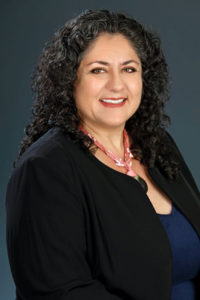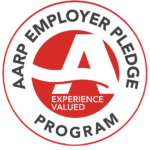
Navigating career transitions can be difficult for anyone, but older workers face a unique set of disadvantages. Retirement savings shortfalls and ever-increasing costs of living either force retirement-age workers to continue working or pushes retirees to re-enter the job market. Older workers are often overlooked in the hiring process and face age-based discrimination.
In a 2018 report, the Equal Employment Opportunity Commission found that even though 50 years had passed since Congress outlawed the practice, “age discrimination remains a significant and costly problem for workers, their families and our economy.” In that same year, a “Value of Experience Survey” by AARP also revealed distressing news. Nearly 1 in 4 workers aged 45 and older have been subjected to negative comments about their age from co-workers or supervisors; about 3 in 5 have seen or experienced age discrimination at work; and 76 percent of these older workers see age discrimination as a hurdle to finding a new job.
Census data indicates that population by age in Napa, Sonoma and Marin counties is 35, 37 and 40 percent respectively for those aged 50 to 79. Will it be easy for the job seekers among them to convince employers that they have a depth of knowledge and experience that is not easily replaced, can be tapped in many different ways, and is worth paying for?
The value of experienced workers
With the rise of automation and artificial intelligence, companies are discovering that there are certain human skills technology can’t replace. Among these are emotional maturity and lived experience which take years to develop. Changing demographics and fallout from the coronavirus pandemic should motivate business leaders to focus on age-inclusivity as a competitive advantage.
At least that’s what AARP, the 64-year-old nonprofit organization founded “to empower people to choose how they live as they age,” is encouraging with its Employer Pledge.
The nationwide pledge program currently lists 2,000 businesses that have signed on. These leaders have affirmed the value of experienced workers and are committed to recruit across diverse age groups. They promise to consider all applicants on an equal basis regardless of age. They also agree that individuals aged 50-plus should have a level playing field in competing for and obtaining jobs.
Among the advantages of hiring older workers emphasized by AARP are: less turnover and longer average tenure because they are living and working longer; higher EQ (emotional quotient) skills; and ability to mentor younger workers. PwC’s 20th Global CEO Survey noted that chief executive officers ranked emotional intelligence and leadership among the most valuable and hard-to-recruit skills.
Patti Hill, the founder and managing principal of Penman, a boutique public relations firm for the tech industry, is quoted at the AARP Employer Pledge site: “…mature individuals who come from different backgrounds will typically have the capability of strategizing on behalf of the client. The PR part is easy, but I can’t teach strategizing, I can’t teach maturity.”
Businesses who sign the pledge are not simply left with an “Experience Valued” sticker to post on their websites. Benefits for signatories include access to AARP online career fairs, training resources, a media kit, webinars, discounts on job board postings and other privileges, services and opportunities. If they follow up on their commitment with concrete action, leaders might discover unexpected productivity and innovation within their organization as a result of creating an age-diverse environment.
Soulmates Animal Care affirms experienced workers
Tess Hoogsted, who runs day-to-day operations for Soulmates Animal Care Referral Network in Marin County, says they found out about the pledge program when her company tapped AARP’s resources to boost their cadre of workers during the pandemic. Soulmates operates with independent contractors and three employees—a bookkeeper, the founder/CEO Karla Rasmussen and Hoogsted.

Hoogsted consulted with AARP customer service to tweak her help-wanted ads to better appeal to 50-plus job seekers. Currently, Soulmates has 20 to 25 contractors, about half of whom are in the experienced-worker age bracket.
“We’ve been in business since 1993 and serve about 50 clients a month,” Hoogsted says. “One of our house-sitters, with special knowledge of cats, has been with the network for 16 years. She is very well-versed in animal care and is valuable to the company for her years of experience. Ultimately, we are trying to target retired people who love to do cat visits and dog walking for both their own pleasure and to earn extra income.”
Expanding the meaning of diversity
In a 2021 article for Harvard Business Review, Noa Gafini writes: “Organizations often have a narrow view of who they want to hire and retain. To make progress on this issue, leaders need to focus on traditional definitions of diversity (race, gender, ethnicity and sexual orientation) and also expand their lens to consider age, socioeconomic status and lived experience as well.”

Personnel Perspective’s operations manager, golbou ghassemieh (who prefers to use lower case letters for her name), is a senior consultant with 18 years’ experience in the Human Resources field. She agrees that age and experience should be included in the definition of DEI (Diversity, Equity and Inclusion).
“You can’t get expert level credentials except over time,” ghassemieh says. “The new generations coming into the workplace are the most educated; many have master’s degrees. They’ve been through years of schooling and textbook learning, but don’t have hands-on experience.”
Much of the work Personnel Perspective is doing now is leadership training because the younger employees are short on supervisory experience. They have moved from peer relationships to lead worker without the benefit of a mentor.
“In my first role as a young leader, I leveraged individuals on my team who were older and contributed from their years in previous careers,” ghassemieh recalls. “They recognized the learning curve I was in. I could ask questions about how to do this or that. They were great sources of support in building trust. These experienced folks would then become the influencers on the team and bring everyone else along with me.”
She notes that in years past, there was the idea that all Baby Boomers were going to retire out. By 2028, the share of older workers is projected to increase by 51 percent for those age 65-plus and 105 percent for those age 75 and older. By 2034, adults age 65-plus will outnumber children 18 and under and population growth is expected to slow considerably, according to U.S. Census Bureau and Bureau of Labor Statistics employment projections. There is a demographic imperative to hire those who are older, healthier and living longer.
Because of financial stresses or other factors (including simply being restless and wanting something interesting to do), retirees are realizing they must come back into the workforce in some capacity. If a company allows for part-time employment and maximum flexibility, management has the opportunity to bring in experienced individuals who can mentor younger workers. An advantage for the semi-retired person might be earning supplementary income in a chosen lower-level position with minimum stress.
“Find out what their skills are, what they enjoy doing, and then take advantage of their wisdom and history to make it mutually beneficial for the senior workers and the organization,” ghassemieh says.
Training for a multi-generational work environment
It takes some effort to get an age-diverse team to gel. Part of diversity training includes helping the generations relate to each other through a clear understanding of each other’s backgrounds and working styles. In Personnel Perspective’s sessions, participants discuss what has happened historically—the major events for each generation, like World War II, the Vietnam War, the housing crisis, the Great Recession, and of course, the coronavirus pandemic and the accelerating effects of climate change.
If people know where their co-workers are coming from and why, that can start to break down some of the barriers. The younger generation has been schooled differently and exposed to newer ways of going about their work. And, of course, those in their 20s and 30s have been practically born online and their communication styles are very different from their elders. Two stories came to mind for ghassemieh.
“Recently I was looking into this because someone was offended by my using a thumbs-up emoji. What is the deal with the thumbs-up, why is that offensive? Apparently, the way the younger generations use the thumbs up, it’s dismissive and passive/aggressive. Gen X and Baby Boomers use this emoji to say ‘Yes, I got your message, I hear you.’ To them, it’s a quick acknowledgement; the younger generations say it’s rude.”
“About five years ago I heard from a colleague that my writing was an older person’s writing because I put two spaces after a period. That’s how I learned to use a keyboard—on a typewriter. She hadn’t even met me and she knew I was in another generation. We all came into technology in a different way and need to take the time to understand. Younger folks are used to doing everything by text message, with shorthand. For us in the older generations, spelling, grammar, writing complete sentences were pounded into us.” However, ghassemieh is not implying that her colleagues should abandon spelling and grammar so they don’t seem “old.” If you know what your boss expects in terms of written communication, it’s to your advantage to carry out those expectations in the work context no matter what your age.
“Everybody wants to work with people they can relate to, who resonate with them; that’s why much of our leadership training has to do with emphasizing what we have in common, rather than our differences,” ghassemieh points out. “What are the goals and values they all share, regardless of wardrobe, the movies they like, how they use their spare time? Company leaders still need to foster that culture and set the example.”
This comes back to diversity, equity and inclusion policies. How do supervisors support each member of the team to do and give their best? It might be setting up mentoring pairs of more experienced and less experienced. It might be the ways an employment agreement is crafted that allows flexible hours.
“I have a client in his 70s who says he is useless after 3 p.m., can’t think as well after six hours working, so I know to schedule our meetings in the morning! You accommodate older workers the way you would accommodate someone who had carpel tunnel by giving them voice-activated software,” the consultant says.
“I know if I had a group of brand new college grads, I would want an experienced professional on my team to help show them the ropes. The one doing the coaching feels good about sharing the knowledge they spent the better part of a lifetime getting and satisfied that they are contributing something to the next generation.” 
One last challenge for older workers may be the job application process itself. Some online sites for job seekers might have discrimination built right in. In 2017, the Illinois attorney general, Lisa Madigan, opened an investigation after a 70-year-old man called her to complain that he’d been unable to use a résumé building tool on a job search site. The drop-down menu that required the applicant to select the year when they graduated from college or got their first job would not go past 1980. Madigan contended that could exclude anyone over 52. She contacted Monster.com, CareerBuilder, TheLadders.com, Beyond.com, Indeed.com, and Vault.com to make them aware of the problem. The companies responded in varying ways, but the point was made that the issue needed to be resolved.
Madigan said that this was still discrimination. “Anybody who’s alive and wants to look for a job should be able to do so and to put in accurate information.”
Applicants can help avoid age bias by not listing the years of college graduation (if possible) or the exact dates of employment in favor of the number of years with a particular employer. Some companies have adopted “blind” applications, giving only a number to an applicant to avoid ethnicity bias by being able to see the last name.
Personnel Perspective’s ghassemieh again offers suggestions for avoiding age bias—this time to the person reviewing applications.
“You want to know how recent the person’s skill set is, because what’s required of an office manager today may have been different when the only software they needed to use was Word Perfect.”
At the same time, she cautions, hiring teams need to examine their own conscious and unconscious biases. “I had one client tell me they would automatically eliminate anyone who had worked at a government agency because they would not fit well in the private sector,” she says.
But such limiting approaches ultimately steer employers from what should be the primary focus of applicant assessment: skills, knowledge and experience. She says the No. 1 question a hiring manager should ask when reviewing any application should be: Does it match the job I’m hiring for?
“When you do a first evaluation, nothing besides that matters.”
Sign the pledge and affirm the value of experienced workers
“I think it should be part of every company’s DEI [diversity, equity and inclusion] program to sign up for AARP’s Employer Pledge,” says Personnel Perspective senior consultant, golbou ghassemieh. She was surprised to see so that so few businesses located in Sonoma, Napa and Marin counties were among those on the list of participants. “I can only assume that they just haven’t heard about it.”

Those companies who sign the pledge affirm the value of experienced workers and commit to create an organization or business that:
- Believes in equal opportunity for all workers regardless of age;
- Recognizes the value of experienced workers;
- Believes that workers who are 50-plus should have a level playing field in their ability to compete for and obtain jobs;
- Recruits across diverse age groups and considers all applicants on an equal basis.
Benefits for signatories include access
to AARP online career fairs, tools and resources, discounts on job board postings, media kits, webinars and other services, privileges and opportunities. Search online for AARP Employer Pledge Program, or visit campaigns.aarp.org for more information.
AARP offers resources for the older job seeker as well. Among these are: Back to Work 50+, a foundation program that provides training and tools older adults need to compete for today’s jobs; a free résumé review for everyone and custom professional résumé retooling for members.
Suggestions for creating a successful age-diverse workplace
–Include age in Diversity, Equity and Inclusion training programs
–Allow flexibility (i.e. hours and number of days/projects) for older workers
–Help your multi-generational team understand the lived, historical experience of all members
–Help your multi-generational team understand different communication styles
–Focus on commonalities in expression and values rather than differences
–Create mentoring/coaching pairs to enliven your team
–Be aware of how you assess job applications. Are your criteria based on skills, knowledge and experience?
Extra Help
The County of Sonoma regularly hires “Extra-Help” employees who augment the County’s regular workforce. This type of employment helps cover short-term needs, seasonal, and intermittent work assignments. Any member of the public may apply for this type of work. Employment like this can be ideal for an individual who is transitioning from full-time work/career to full-time retiree. Additionally, the County may hire County retirees on a limited basis for special projects and to help fill gaps.
“County of Sonoma retirees are uniquely qualified to return because most typically, they are brought back to perform roles and responsibilities that they formerly did, so they can hit the ground running,” says Christina Cramer, Human Resources Director.
Cramer adds that individuals who have retired and are retirees of public sector retirement systems can work as retirees for their respective retirement systems. The legislation that allows this is the California Public Employers Pension Reform Act (PEPRA). It allows public employers like the County to re-hire their respective retirees per defined circumstances.



